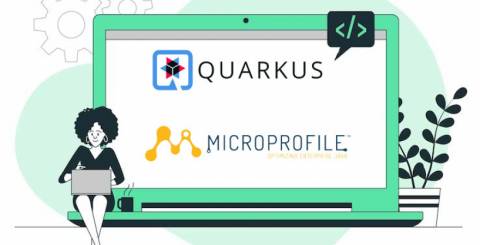Is Quarkus A Microprofile Implementation?

Quarkus is a MicroProfile implementation that emphasizes exploring Java Software Development in Kubernetes and containers more generally effectively. These settings have very dynamic characters.
To modify variations in traffic and meet the demands of continuous deployment, Microservice containers appear and disappear. When executing Microservices on Kubernetes nodes, quick startup upgrades, operational agility, and effective memory use is important to save costs. Quarkus is exceptional at both.
Writing transferable Microservices that can function across different MicroProfile implementations is one of Eclipse MicroProfile's great features. This gives programmers a fantastic scope of exploration from which to pick one depending on technical or commercial needs. If you haven't heard, Quarkus is a brand-new MicroProfile implementation on the trend!
In this blog, let’s understand and gain a deep awareness of Quarkus and MicroProfile.
Quarkus - A Brief Explanation:
A systematic platform for Serverless, cloud, and Kubernetes settings, Quarkus seems to be a full-stack, Kubernetes-native Java framework designed for JVM (Java virtual machines) and native compilation. It especially analyzes Java for containers.
Quarkus employs well-known enterprise-grade frameworks supported by grades and specifications rather than creating anything from scratch and makes them GraalVM compliable with a binary.
One concern is that Java Microservice runtimes frequently reduce developer productivity. Developers are needed to save the file, rebuild the program, prelaunch the application, and reload the browser each time they make a change. These may take tens of seconds, which would drastically reduce a developer's productivity. That rapidly adds up to a significant sunk resource cost for a company when multiplied by the number of engineers on a team over time.
Due to the difficulty of creating and deploying Java Microservices, developers and DevOps teams have started evaluating alternatives, including Node.js and Golang, which have lower RAM needs and quicker startup times.
On the same technology, these alternatives may also reach deployment densities of 5x to 10x, which considerably lowers costs.
Taking a new look at the requirements of the contemporary Java Microservice developer, Quarkus seems to be a Java runtime. It is intended to be as resource-efficient as Golang and as efficient for developers as Node.js.
Quarkus is both fresh and recognizable to many developers at a similar moment. While maintaining the APIs that developers are already familiar with, has many new, useful capabilities.
Runtimes frequently do not consider the target environment when designing Microservices. The majority of runtimes are deployment environment independent to be generally applicable.
Although Quarkus is utilized in a wide range of deployment scenarios, it features particular improvements and adaptations for Kubernetes and Linux containers. Quarkus is known as Kubernetes Native Java as a result.
Developer Joy:
Quarkus places a high premium on developer happiness. Although Java is a "static" language, developers are justifiably smitten with the efficiency of dynamic language runtimes, including Node.js, and Quarkus is working to provide that experience.
Live coding, which allows code changes to be recognized, recompiled, and reloaded without bothering to restart the JVM, is the feature that gives developers the most delight.
When Quarkus is launched in developer mode, live coding is activated. When Quarkus gets external events, including Kafka messages or HTTP requests, it explicitly checks for code modifications.
Describe MicroProfile:
The corporate Java ecosystem is moved into the Microservices architecture via Quarkus' integration with the MicroProfile standard.
Some APIs are based on the Jakarta EE standard, including JSON-P, CDI, and JAX-RS. The Java community created the remainder.
Why Are Microservices Protocols Necessary?
For around 20 years, Java EE has served as the industry standard for enterprise Java requirements. However, Java EE has always prioritized backward compatibility and a 3-tier monolithic design that has undergone slow, measured progress.
Between 2014 and 2017, Java EE's evolution ceased, coincidentally with the industry's rapid adoption of Microservices. The Java EE community started experimenting and releasing early Microservices APIs during the break.
The possibility of API fragmentation between Java runtimes, which had been renowned for application portability, was on the rise. There was also a chance of losing transferable abilities.
Microprofile Community Fundamental Concepts:
As a member of the steering committee of the Eclipse Foundation, MicroProfile adheres to several of the foundation's fundamental principles, including vendor neutrality, open source, community participation, and cooperation.
The following new precepts are added to those in the proposed charter of the Microprofile Working Group:
Constrained Processes:
MicroProfile makes use of both the Eclipse Foundation Specification Process and the Eclipse Development Process. Only when necessary are new MicroProfile-specific processes generated.
Implementation Comes First:
Only once an implementation has been made and the description and application have had enough time for community evaluation are MicroProfile specifications made public.
Experiment with New Approaches:
The MicroProfile community offers an industry testing ground for incubating and experimenting with established issues requiring cross-Java-Runtime APIs, gathering user input, and quickly adapting and iterating solutions.
No Assurance of Backward Compatibility:
Backward compatibility may be broken in major revisions of a standard created using MicroProfile.
Encourage The Use Of The Brand:
Establish rules that would permit the free use of the Microprofile name.
Openness:
The values of transparency, inclusivity, and removing obstacles to participation are highly regarded. The recommended format is open lists and gatherings.
For important choices, lists are preferred. Specifications have been handled in such a way that all MicroProfile committers have open access to them.
Low Entrance Threshold:
MicroProfile wants to run a working group at a cheap cost. Every year, as the membership changes, the budget will be reviewed for ways to keep costs and fees low.
Wrapping Up:
A Microservices architecture is more difficult to create and implement than a monolithic program. In our opinion, Microservices might motivate you to create services that are appropriate in terms of the application infrastructure.
Except for APIs and pipelines, most of the Microservices described here are either brand new or differ from how they are implemented in monolithic apps. The reason is that the program has now been divided into multiple components that are all connected across the network.
Quarkus is a fantastic option since it works well with Kubernetes if you intend to create Microservices and deliver them to the system. Most Microservices are easy to implement and just need a few lines of code.
Similar Articles
The education industry is not left behind by the new digital world shift. E-learning has received much consideration with the help of technological factors coupled with the ever-increasing demand for convenience and personalization
Managing a wide range of assets, from IT equipment to digital resources, can be overwhelming without the right tools. Businesses often struggle with asset mismanagement, leading to delays, unexpected costs, and compliance issues.
E-learning has become a quintessential wave through which learners access education in today’s te
Are you tired of keeping up with regulatory requirements and managing risk, which can feel like navigating a labyrinth? Organizations across industries face mounting pressure to maintain compliance while simultaneously driving growth and innovation.
Anyone even vaguely familiar with today's fast-paced digital world would know that e-commerce businesses face intense pressure. Pressure to deliver exceptional customer experiences while also maximizing their profits. To achieve this delicate balance, companies operating in this space must now put the power of technology to work
Intelligent technology-driven solutions are now guiding industries across all sectors. Innovative and disruptive technologies like Artificial Intelligence (AI) and Machine Learning (ML) are driving these changes, which play a crucial role in designing and developing intelligent solutions.
The introduction of Artificial intelligence (AI) healthcare has caused a radical change in the way that medical care is provided. It gains paramount importance when it comes to customised treatment regimens.
Graphical presentation of data and information in visual formats like charts, maps, and graphs is termed data visualization. This method makes complex data more accessible and easily understandable bringing out the trends and patterns from raw data, which can be used to significantly enhance customer experience
Integrating AI into your business app isn't just a matter of staying current; it's about unlocking new dimensions of efficiency, personalization, and customer satisfaction. Among the most groundbreaking AI technologies is ChatGPT, a language model that simulates human conversation with incredible accuracy.









